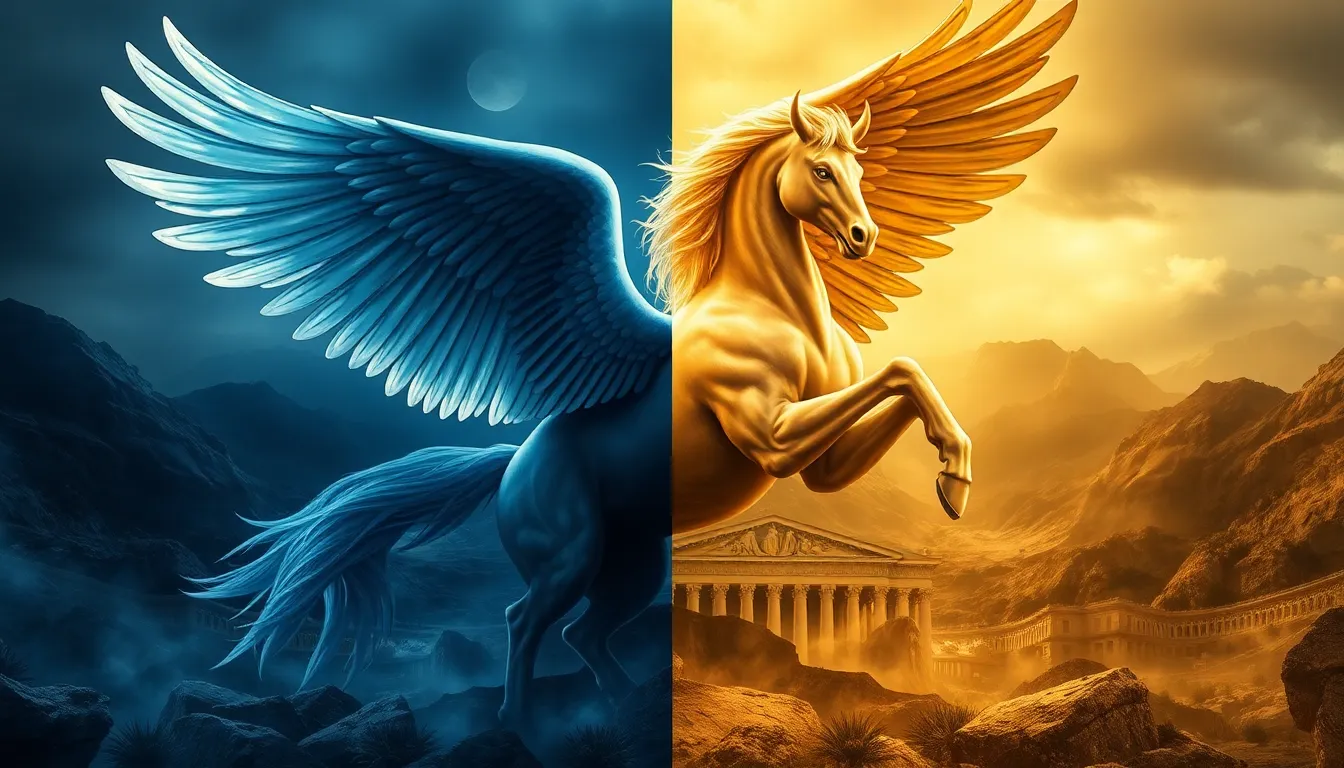The Dual Nature of Pegasus: A Study of Light and Darkness in Myth
I. Introduction
Pegasus, the winged horse of Greek mythology, is a figure that embodies both the ethereal qualities of light and the ominous aspects of darkness. His origins and adventures weave a narrative that transcends mere tales; they explore the complexities of existence, embodying the dualities that define the human experience. In mythological narratives, the interplay between light and darkness often serves to illustrate moral, philosophical, and psychological themes. This article aims to delve into the dual nature of Pegasus, examining how he symbolizes both inspiration and chaos, and what this duality signifies in the broader context of mythology.
II. Historical Context of Pegasus
Pegasus is believed to have originated from the blood of Medusa when she was slain by the hero Perseus. This mythical creature is not merely a horse; he is a symbol of poetic inspiration and serves as a bridge between the earthly and the divine. Throughout history, Pegasus has appeared in various myths and stories, each depicting different facets of his character.
- The Birth of Pegasus: Emerging from the ocean, Pegasus was born from the blood of Medusa, highlighting both the beauty and horror of creation.
- His Connection to Bellerophon: Pegasus is famously associated with the hero Bellerophon, who rode him to defeat the monstrous Chimera, symbolizing triumph over chaos.
- Cultural Interpretations: Across different civilizations, Pegasus has been interpreted in various ways, from a symbol of inspiration to a harbinger of destruction.
III. Pegasus as a Symbol of Light
Pegasus is often depicted as a creature of light and beauty. His image has inspired countless artists and writers throughout history, serving as a muse for creativity and inspiration.
- Representations in Art and Literature: Artists from ancient Greece to the Renaissance have depicted Pegasus in various forms, illustrating his majestic wings and ethereal presence.
- Inspiration and Creativity: Pegasus is frequently associated with the Muses, the goddesses of inspiration in Greek mythology, symbolizing the creative process.
- Heroic Narratives: In stories like that of Bellerophon, Pegasus represents the triumph of good over evil, showcasing the hero’s journey and the light of victory.
IV. Pegasus as a Symbol of Darkness
Despite his associations with light, Pegasus also has a darker side that cannot be overlooked. His mythology contains elements that reflect chaos and destruction.
- Darker Aspects of Mythology: The very blood from which Pegasus was born is tied to the violent act of slaying Medusa, suggesting that creation often arises from destruction.
- Chaos and Destruction: In some tales, the presence of Pegasus heralds chaos, particularly in stories where he is linked to the tumultuous events of war.
- Human Emotions and Struggles: The duality of Pegasus reflects the internal conflicts people face, representing both the aspiration for greatness and the chaos that can accompany such pursuits.
V. The Intersection of Light and Darkness
The coexistence of light and darkness in the myth of Pegasus offers profound insights into the nature of duality in mythology. This duality is not merely a contrast but a complex relationship that shapes the narrative.
- Coexistence of Light and Darkness: Pegasus embodies the idea that light cannot exist without darkness; his story illustrates how triumph is often born from struggle.
- Balance of Duality: The dual nature of Pegasus serves as a reminder of the balance that exists in life, where joy and sorrow, creation and destruction, are intertwined.
- Similar Mythological Figures: Other figures in mythology, such as the phoenix and the sphinx, also embody dualities, representing various aspects of human experience.
VI. Modern Interpretations of Pegasus
In contemporary culture, Pegasus continues to be a powerful symbol, influencing various forms of art and media. His dual nature resonates with modern audiences, reflecting ongoing societal themes.
- Contemporary Art and Literature: Modern artists and writers draw upon the imagery of Pegasus to explore themes of freedom, creativity, and the human condition.
- Popular Culture: Pegasus appears in films, music, and literature, often representing hope and inspiration, but sometimes also chaos and conflict.
- Relevance of Duality: The dual nature of Pegasus mirrors contemporary societal struggles, highlighting the importance of understanding both light and darkness in our lives.
VII. Psychological Perspectives on Duality
The concept of duality is significant in human psychology, revealing the complexities of our internal experiences. The myth of Pegasus serves as a lens through which we can examine these conflicts.
- Significance in Human Psychology: Duality reflects the internal struggles faced by individuals, such as the conflict between aspirations and fears.
- Internal Conflicts: The myth of Pegasus portrays the journey of self-discovery, illustrating how one must confront both light and dark aspects of the self.
- Role of Archetypes: Pegasus can be seen as an archetype representing the human quest for understanding and balance between opposing forces.
VIII. Conclusion
In conclusion, the dual nature of Pegasus serves as a rich tapestry of light and darkness, illustrating the complexities of existence through mythology. His story is a reminder of the balance between creation and destruction, inspiration and chaos. The lasting impact of Pegasus in myth and culture remains significant, encouraging us to explore the dualities within ourselves and the world around us. Understanding the interplay of light and darkness in mythology not only enhances our appreciation of these ancient tales but also enriches our comprehension of the human experience.




